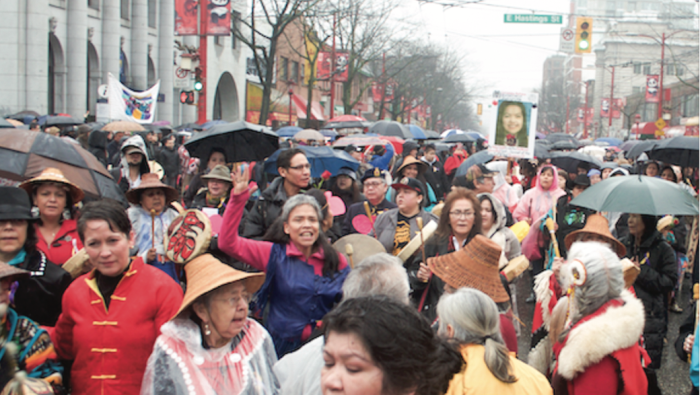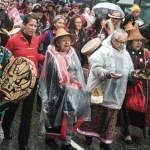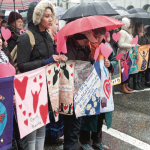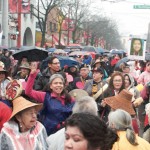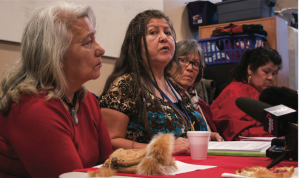Fighting for sisters… Fay Blaney’s life
By Cara McKenna
On a typically grey winter day in Vancouver, Fay Blaney is walking through the heart of the Downtown Eastside with several other Indigenous women’s advocates.
The women enter the Aboriginal Front Door Society where they’re about to hold a press conference to outline their concerns about the federal government’s recently launched inquiry into Canada’s epidemic of missing and murdered Indigenous women (MMIW).
All of them have been fighting for this inquiry for many years, before the story of serial killer Robert Pickton preying on women in the area began making headlines, and before the general public began paying attention.
They’ve been the ones talking to and laughing and crying with the victims and their families.
Twenty-five years ago, Blaney and others were fighting for the rights of Indigenous women when the government just “didn’t care,” she said.
Back then, Aboriginal women who died on the Downtown Eastside would get ten-minute funerals, if any, despite cultural protocol calling for days-long ceremonies to say goodbye.
The issue is now getting increased attention and the MMIW inquiry is happening, but the committee is worried that the government isn’t putting enough focus on the misogyny and colonialism at the root of the problem. And they’re going to tell Indigenous Affairs Minister Carolyn Bennett exactly that, right after they tell the media.
Blaney, her long hair in braids, warmly greets several regulars who are sitting in a circle of folding chairs drinking coffee from Styrofoam cups. People around her hustle to rearrange the room to make space for news reporters, who have already started arriving.
She sits at a newly moved table, her voice and demeanour unshakable even after multiple interruptions from the centre’s staff and a CTV reporter who’s wondering where to place her microphone.
Blaney’s daughter brings her tea and toast.
“They’re expecting me to help organize this,” Blaney explains calmly as she sips her tea and directs the room between questions. Her steadfast manner is a product of, and has led to, her three decades as a powerful voice for Indigenous women.
It’s been a lifelong journey for Blaney, whose first true act of rebellion happened when, still dealing with a history of violence and sexual abuse within her family, she ran away from residential school in Mission, BC.
“I couldn’t handle the constant punishment,” she said. “When I began running, I came to the city.”
Blaney pinpoints her start in activism to when she was part of an all-women’s occupation of the BC offices of the Department of Indian Affairs to protest actions of its leadership in the early 1980s.
She went on to study at Simon Fraser University in the early 1990s, another part of her liberation, and became a strong voice for Indigenous women in the years following as part of a number of different organizations and groups.
In the early 2000s, she took her advocacy home to Homalco First Nation where she grew up, as documented in the 2006 documentary Finding Dawn.
Before colonization, the Homalco people lived around Church House and Bute Inlet. They were healthy and fish were abundant. But the community was transplanted to an area far from the sea near the Campbell River airport. It was land-locked with no access to the ocean. The nation continues to mourn its loss.
There have been serious residual impacts, and the resulting problems made it a scary place at times when Blaney was a child. The community has faced extreme social issues including, notoriously, physical and sexual violence towards its women, something Blaney watched happen to her mother who ran away to escape the abuse.
But Blaney, no longer afraid, came into her community with guns blazing, ready to tackle the problem with other abuse survivors within the community. Despite their noble efforts, Blaney says now, ten years later, abuse towards women is still a problem that Homalco and many other communities continue to grapple with.
Studies peg the rate of Indigenous women who have experienced violence within their own communities as high as 90 per cent.
“I did my best,” Blaney said. “It didn’t work out for me. There’s just too much internal strife.”
She sees women from her home community in Vancouver every so often, she said, through her work with the Downtown Eastside Women’s Centre.
Blaney is an uplifting presence to other Aboriginal women not only because she can relate to their struggles, but because she also uses her culture to guide her work.
When she was a young teen, she went through puberty rights, which involved bathing in a river every day for a year and cooking for her community.
“I served the elders, I served the community, so those teachings have been invaluable and gave me a discipline that I could not have attained otherwise,” she said.
“Now when I do this work I’m very disciplined. It’s self-sacrificing in a lot of ways, but I think that’s our teaching anyways, as Indigenous peoples.”
By now, the small room is near-full of TV crews, reporters from many of the major news outlets and several Downtown Eastside residents who are gathering at the windows to see what all the action is about.
Her fellow committee members are beside her at the table, a cluster of microphones now in front of them, and cameras begin to flash. Blaney looks apologetic, but everyone is looking at her expectantly.
There’s a fire behind her eyes as she gets ready to speak, articulate and strong words that come from years of education and experience, but more than that, a real thirst for change.
When asked how she feels that none of this, the inquiry, the interest, would be happening without people like her, she stays humble, choosing to acknowledge those who came before her.
For Blaney, it’s not a choice, it’s what she’s always done — standing up for her sisters.
The CTV reporter who’s been waiting hurries up to the table and turns on her microphone.


